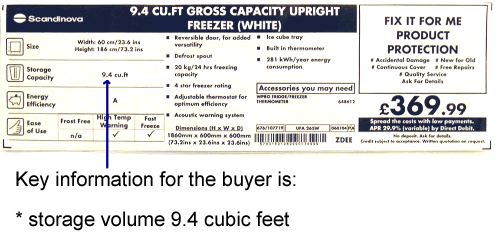Although there is now a standard way of measuring key parameters of a home appliance, there are unfortunately some confusing claims about capacity and performance that might muddle you.
Beware of capacity claims that do not add up
Today there is a statutory way of displaying information on household appliances namely the energy label (See the government’s Shopper’s Guide to Green Labels). However, retailers frequently display different information in additional labels which can confuse you.
For example, one retailer displays the statutory energy label on a freezer

but the retailer’s own label attached to the same freezer shows different data

Unfortunately the capacity figures do not match up. The “storage capacity” given by the retailer as ‘9.4 cubic feet’ equates to 266 litres – not the fresh food volume of 228 litres on the Energy Label. Whatever gross capacity the cubic feet refer to, it is not the usable food volume that consumers care about. In fact if a customer used the “storage capacity” figure they would actually get less than 86% of that volume to store food!
Representing capacity in different ways is misleading to consumers as it easily sets false expectations.
Don’t be muddled by cubic feet
Many British retailers insist on labelling the capacity of appliances in cubic feet. This is not helpful when basic appliance dimensions – like those of kitchen units – are metric. Worse still, it is not easy to imagine the capacity in terms of everyday items of food.
Is it easy to imagine the capacity of a microwave oven in terms of pairs of old boots (cubic feet)?

or is it easier to imagine it in terms of fruit juice cartons (litres)?

Check the usable capacity of ovens, fridges and freezers in litres.
Strangely enough, although most microwaves are labelled in cubic feet by retailers,

The manufacturers label their product capacity in litres.

Although the BTU is an old-fashioned unit, it is frequently used by retailers to describe the output of heaters or air conditioning units.

Unfortunately, when products are described in this way, it is difficult for a buyer to compare product performance without calculation.
For example, a range of cookers was advertised describing electric, gas and oil variants in terms of BTU/h performance.

While the figures in BTU/h permit comparison of the different variants, it is impossible to compare the performance with other gas or electric cookers which quote performance in kilowatts. Worse still, it is hard to estimate the electric and gas running costs as electricity and gas utility bills price energy in kilowatts.
Disclaimer
The examples of what UKMA views as consumer-unfriendly practices are real and representative of how household appliances are sold in Britain today. The fact that certain examples have been used should not be taken to be singling out particular retailers for criticism. These practices are unfortunately widespread and are a direct result of a poorly executed transition from imperial to metric by successive governments. UKMA campaigns for a reform of the way that products, such as home appliances, are described to give consumers better quality information for comparing products.
